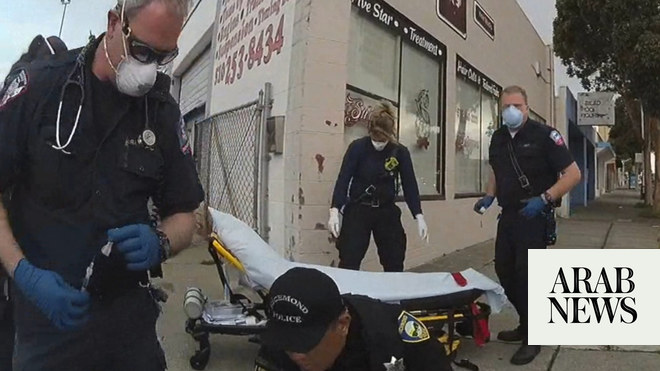
A controversial unproven medical condition which is rooted in pseudoscience and disputed by doctors is routinely being used in Britain to explain deaths after police restraint, the Observer has found.
“Acute behavioural disturbance” (ABD) and “excited delirium” are used to describe people who are agitated or acting bizarrely, usually due to mental illness, drug use or both. Symptoms are said to include insensitivity to pain, aggression, “superhuman” strength and elevated heart rate.
Police and other emergency services say the labels, often used interchangeably, are a helpful shorthand used to identify when a person who might need medical help and restraint may be dangerous. But the terms are not recognised by the World Health Organization and have been condemned as “spurious” by campaigners who say they are used to “explain away” the police role in deaths.
The American Medical Association rejected “excited delirium” after it was used by police lawyers in the case of George Floyd. California lawmakers banned it as a diagnosis or cause of death in October, saying it had been “used for decades to explain away mysterious deaths of mostly black and brown people in police custody”.
The Royal College of Psychiatrists has also warned that the current definition of ABD, as it is now more commonly known in the UK, could be leading to people “being subjected to avoidable and potentially harmful interventions”. In 2017, a Home Office-commissioned review into deaths in police custody said the terms were “strongly disputed amongst medical professionals”.
Despite the continuing controversy, the Observer has found that the terms are being used by frontline police when deciding whether to use restraint – and by forces and their lawyers to explain deaths after the fact.
In one case, a man who was restrained by five police officers for almost an hour, mostly face down on the ground, after a 999 call that he was “acting strangely”, was said to have been suffering from “acute behavioural disturbance”.
A 2022 inquest heard Krystian Kilkowski, 32, an engineer from Poland, had taken amphetamines, but not a fatal dose, and concluded “serious failures’ in the use of restraint by Norfolk police contributed to his death in August 2020. The Independent Office for Police Conduct (IOPC) recommended further training but cleared the officers of any blame, citing ABD in its report. The disputed condition was listed as a contributing factor on his death certificate.
“Acute behavioural disturbance” and “excited delirium” have been referenced as a cause of death, or a contributing factor, in police watchdog reports and inquests in least 44 restraint cases since 2005, according to research by the charity Inquest, the Royal College of Psychiatrists and the Observer.
Deborah Coles, the executive director of Inquest, said there was a danger that use of the terms risked deflecting attention from the “inherently dangerous” use of restraint by police for people in crisis.
She said references to ABD as a condition or diagnosis were inappropriate and that they had been used, “without any doubt, to try and downplay the significance of the police use of force and explain away the role of dangerous and negligent restraint. That can really undermine effective public scrutiny and accountability,” she said.
Use of the term in mental health settings is also thought to be rising, with a study by King’s College London finding references to ABD had become more prevalent since 2019 – and that it was twice as likely to be included in assessments of black people than those who were white, which the researchers said “may contribute to existing racial inequalities in the use of coercive measures during crisis presentations”.
Suggestions that people with ABD can display increased strength and have higher pain tolerance played on racial stereotypes and were of particular concern, the Royal College of Psychiatrists said.
Dr Trudi Seneviratne OBE, registrar at the college, said: “The way the term acute behavioural disturbance is defined and understood varies significantly across professions. This is deeply problematic because of the way in which some signs and symptoms play into racist stereotypes.
“The college is concerned that this term can be used to minimise the role of restraint in explaining why someone has died. There’s a risk that current definitions may undermine effective accountability, particularly in relation to deaths where there was no underlying physical illness prior to the use of restraint.”
The issue of excited delirium has received renewed attention after a podcast by Jon Ronson, Things Fell Apart, detailed how the term was still being widely used in the US decades after it was debunked. The term originated in Miami in the 1980s after 32 black women who worked as sex workers were found dead, naked from the waist down and with no obvious injuries.
The cases perplexed investigators until Charles Wetli, deputy chief medical examiner for Dade County, concluded that the women had died due to a “combination of cocaine and sex”, a phenomenon he termed “excited delirium syndrome”. It was later discovered that the women had been murdered, most likely choked during forced oral sex by Charles Henry Williams, 38, who was linked forensically to the cases.
Even after the truth was discovered, Wetli continued to promote his theory that excited delirium was a real condition. It has since been relied on to explain sudden, mysterious deaths after police contact in the US and elsewhere.
Police receive explicit training on ABD and are taught how to recognise it. Current College of Policing professional guidelines refer to ABD as both an umbrella term and a “condition”, despite it not being an official diagnosis, and say symptoms may include “insensitivity to pain and incapacitant sprays”.
The IOPC has also been using both terms on its referral forms, which are used by police forces after a death or serious incident. When filling in the form, police are asked to tick relevant factors in the referral. The first option they are given is: “Acute Behavioural disorder/excited delirium”.
This weekend, the IOPC and College of Policing said they were reviewing the documents to consider whether updates were required. The College of Policing said its guidance focused on presentation, not diagnosis, and was clear ABD was an “umbrella term”, adding that its position was informed by guidance published by health partners such as the Royal College of Emergency Medicine.
It said that more research was needed to inform national policy, but that one of the key messages in its training materials on ABD was for officers to “avoid physical restraint unless absolutely necessary for the safety of the subject, self or public”.
The IOPC said its investigations had shown the need for “clear, well-communicated guidance for police” that helped them identify cases where medical intervention was urgent and restraint posed a “clear and obvious danger”. It said it welcomed new research into use of the terms “to better understand how emergency services can respond appropriately and give the correct care”, but that any changes “must not undo the progress made”.
Dr Habib Naqvi MBE, director of the NHS Race and Health Observatory, said there was a need for a multi-agency approach to ensure “meaningful change” to improve the approach to people in mental health crisis and ensure that deaths after restraint led to lessons being learned. “We can’t just sit back and say: ‘OK, we know this’ and not do anything about it,” he said.
Raju Bhatt, founding partner of the law firm Bhatt Murphy, which has represented the families of victims of police brutality, said addressing the issue was not just a case of reviewing old cases to ensure justice was done. “It is a much more urgent question of stopping more deaths. Now, today, tomorrow, next week,” he said.












